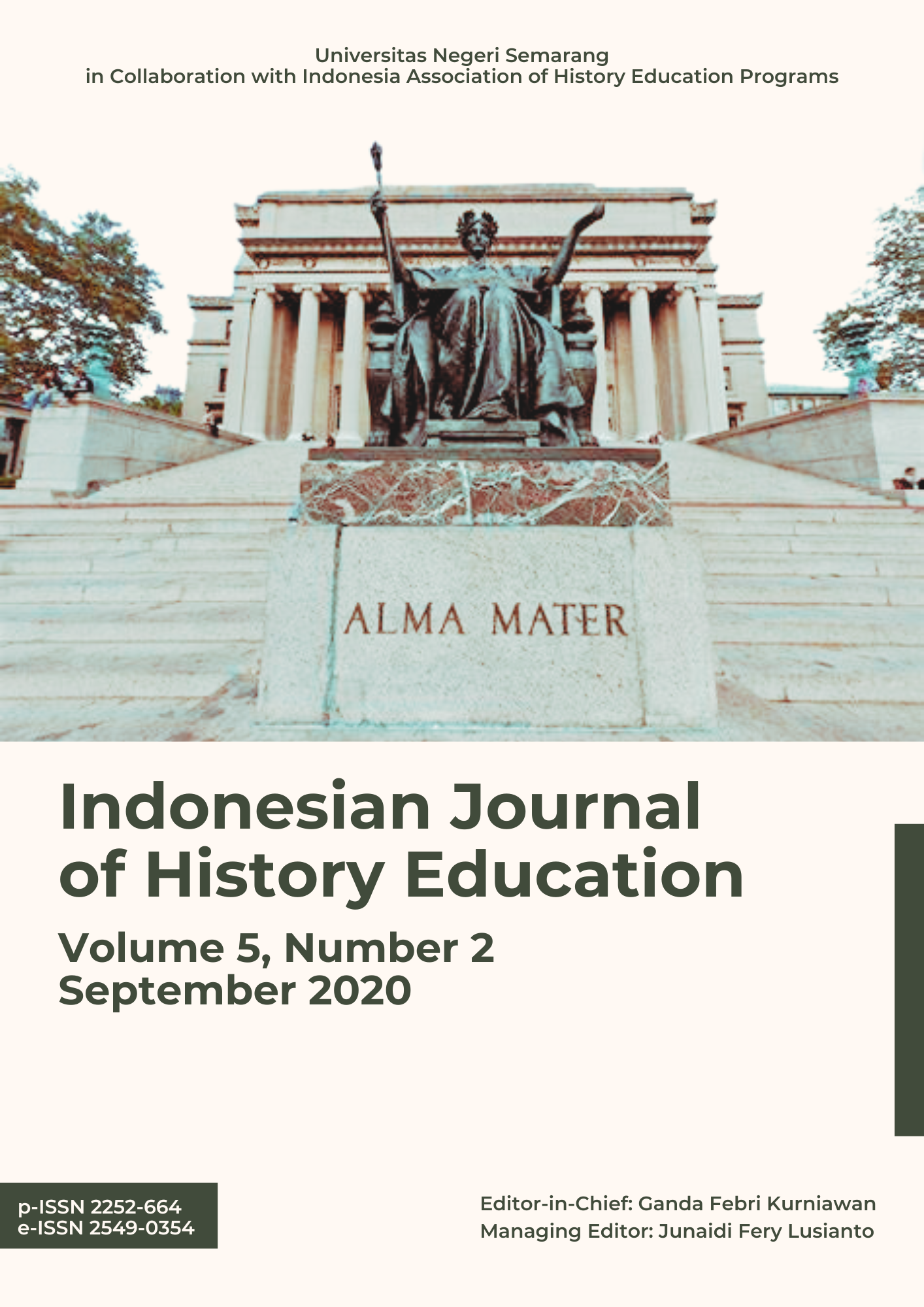Development of History Teaching Materials on the Subject of Indonesian Independence in the Inculcation of Nationalism Values for Grade XI Students of SMA Negeri 1 Kroya
Abstract
The purpose of this study is to (1) Describe the development of teaching materials on the history of the independence of Indonesia in the cultivation of the values of nationalism grade XI. (2) knowing and analyzing the feasibility of handouts about essential events, Indonesia's 1945 proclamation of independence, as seen from the validation results, are performed by expert material and media experts as well as responses to teacher and student feedback. The methods used in this research are Research and Development with the qualitative approach with phases according to Borg & Gall, i.e., potential and problems, data collection, design validation, product design I, design revision I, design II, revision of Validation design II, and trial usage. Powerpoint and book packages are learning materials for use in the classroom. Conventional models, such as lectures, summarize teachers' use in teaching so that students ' reading interest is still low. Based on the results of the validation of the feasibility level of expert material and media expert handout showed results of 94.60% for stage I material validation and 96.01% for the validation of material phase II, as well as media validation to 97.44% for phase I and 98.57% for media validation phase II, besides getting the results of 93.42% teacher responses, as well as the results of the analysis of the responses of the students of 86.61% (both categories).
References
Aditya, M. T., & Muspiroh, N. (2013). Pengembangan modul pembelajaran berbasis sains, lingkungan, teknologi, masyarakat dan Islam (Salingtemasis) dalam meningkatkan hasil belajar siswa pada konsep ekosistem kelas X di SMA NU (Nadhatul Ulama) Lemahabang Kabupaten Cirebon. Scientiae Educatia: Jurnal Pendidikan Sains, 2(2), 127-148.
Asyhari, A., & Silvia, H. (2016). Pengembangan media pembelajaran berupa buletin dalam bentuk buku saku untuk pembelajran IPA terpadu. Jurnal ilmiah pendidikan fisika Al-Biruni, 5(1), 1-13.
Daryanto, D. (2010). Belajar dan mengajar. Bandung: CV. Yrama Widya.
Fannie, R. D., & Rohati, R. (2014). Pengembangan lembar kerja siswa (LKS) berbasis POE (predict, observe, explain) pada materi program linear kelas XII SMA. Sainmatika: Jurnal Sains dan Matematika Universitas Jambi, 8(1), 221053.
Hadi, S. (2016). Pemeriksaan Keabsahan data penelitian kualitatif pada skripsi. Jurnal Ilmu Pendidikan Universitas Negeri Malang, 22(1), 109874.
Hasan, S. H. (2012). Pendidikan sejarah untuk memperkuat pendidikan karakter. Paramita: Historical Studies Journal, 22(1).
Idayati, H. (2016). Pengembangan Bahan Ajar Apresiasi Puisi Kontemporer Berbasis Model Suchman Pada Siswa Kelas Xii Sma (Doctoral Dissertation, Universitas Lampung).
Khotimah, N. (2017). Pengembangan bahan ajar cetak leaflet materi khotbah, tablig dan dakwah kelas XI jenjang SMA (Doctoral dissertation, IAIN Palangka Raya).
Kochhar, S. K. (2008). Teaching of History, terjemahan oleh Purwanta dan Yovita Hardiwati. Jakarta: Gramedia Widiasarana Indonesia.
Mulyono, M. A. (2008). Manajemen Administrasi dan Organisasi Pendidikan. Ar-Ruzz Media, Yogyakarta.
Pradana, A., Pramono, S. E., & Atno, A. (2017). Pengembangan Media Pembelajaran Sejarah Menggunakan Video Dokumenter dengan Subtema Pertempuran Palagan Ambarawa di Kelas XI SMA N 1 Ambarawa. Indonesian Journal of History Education, 5(2).
Prastowo, Andi. 2013. Panduan Kreatif Membuat Bahan Ajar Inovatif. Yogyakarta: Diva Press.
Pratama, N. D. S., Suyudi, A., Sakdiyah, H., & Bahar, F. (2017). Analisis kesulitan siswa dalam memecahan masalah fisika materi usaha dan energi. Jurnal Riset Pendidikan Fisika, 2(2), 82-88.
Pratiwi, I. A. (2015). Pengembangan model kolaborasi Jigsaw Role Playing sebagai upaya peningkatan kemampuan bekerjasama siswa kelas V SD pada pelajaran IPS. Jurnal Konseling Gusjigang, 1(2).
Purbandani, M., & Saring Marsudi, S. H. M. (2013). Meningkatkan Keaktifan Siswa Dalam Pembelajaran IPS Melalui Metode Kancing Gemerincing Siswa Kelas IV SD Negeri O3 Nglebak Tawangmangu Kabupaten Karanganyar Tahun 2012/2013 (Doctoral dissertation, Universitas Muhammadiyah Surakarta).
Purnamasari, I. (2011). Pengembangan model pembelajaran sejarah berbasis situs sejarah lokal di SMA negeri kabupaten temanggung. Paramita: Historical Studies Journal, 21(2).
Sudjana, N. (2009). Media pengajaran. Bandung: Sinar Baru Algensindo.
Sugiono, S. (2016). Metode penelitian kuantitatif, kualitatif, dan r & d. Bandung: alfabeta, 288.
Sulaiman, S. (2012). Pendekatan konsep dalam pembelajaran sejarah. Jurnal Sejarah Lontar, 9(1), 9-21.
Suryani, N., & Agung, L. (2012). Strategi Belajar Mengajar: Yogyakarta. Penerit Ombak.
Susilana, R., & Riyana, C. (2008). Media pembelajaran: hakikat, pengembangan, pemanfaatan, dan penilaian. CV. Wacana Prima.
Vitasari, R., & Joharman, K. C. S. (2013). Peningkatan Keaktifan dan Hasil Belajar Matematika Melalui Model Problem Based Learning Siswa Kelas V SD Negeri 5 Kutosari. Kalam Cendekia PGSD Kebumen, 4(3), 9.
Wati, E. H., & Murtiyasa, B. (2016). Kesalahan siswa SMP dalam menyelesaikan soal matematika berbasis PISA pada konten change and relationship. Prosiding Konferensi Nasional Penelitian Matematika dan Pembelajarannya, 199-209.
Wijayanti, N. P. A., Damayanthi, L. P. E., Sunarya, I. M. G., & Putrama, I. M. (2016). Pengembangan e-modul berbasis project based learning pada mata pelajaran simulasi digital untuk siswa kelas X studi kasus di SMK Negeri 2 Singaraja. Jurnal Pendidikan Teknologi Dan Kejuruan, 13(2), 184-197.
Copyright (c) 2020 Indonesian Journal of History Education

This work is licensed under a Creative Commons Attribution 4.0 International License.
Copyright Notice
An author who publishes in the Jurnal Indonesian Journal of History Education agrees to the following terms:
- Author retains the copyright and grants the journal the right of first publication of the work simultaneously licensed under the Creative Commons Attribution-ShareAlike 4.0 License that allows others to share the work with an acknowledgement of the work's authorship and initial publication in this journal
- Author is able to enter into separate, additional contractual arrangements for the non-exclusive distribution of the journal's published version of the work (e.g., post it to an institutional repository or publish it in a book) with the acknowledgement of its initial publication in this journal.
- Author is permitted and encouraged to post his/her work online (e.g., in institutional repositories or on their website) prior to and during the submission process, as it can lead to productive exchanges, as well as earlier and greater citation of the published work (See The Effect of Open Access).
Read more about the Creative Commons Attribution-ShareAlike 4.0 Licence here: https://creativecommons.org/licenses/by-sa/4.0/.




